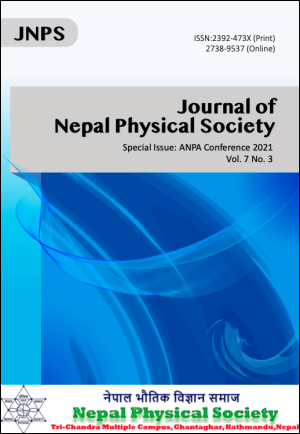Generation of Atmospheric Pressure Dielectric Barrier Discharge (DBD) Using Water Electrode
DOI:
https://doi.org/10.3126/jnphyssoc.v7i3.42187Keywords:
Atmospheric pressure plasma, Electron temperature, Optical Emission SpectroscopyAbstract
In this experiment, an atmospheric pressure dielectric barrier discharge (DBD) generated with a water electrode is investigated by means of optical measurements and imaging. The discharge was generated using a high voltage (0-20kV) power supply operating at 10-30 kHz with water as one of the electrode and borosilicate glass as a dielectric barrier of 2.5mm thickness. This paper reports the generation and characterization of atmospheric pressure plasma in nitrogen environment and its application in the surface modification of polyethylene terephthalate (PET). The generated plasma has been characterized by image analysis and optical emission spectroscopy. Our results showed that the distribution of micro-discharges depends significantly on the inter electrode gap and applied voltage. In order to characterize the discharge, electron temperature has been determined by using line intensity ratio method. The results showed that Te depends on applied voltage and pressure inside the chamber. The values of Te were found to be 1.40 eV and 0.95 eV applied at 1kV and 10kV voltage using 1% concentration. The discharge was produced at various conditions for the study of effectiveness of treatment on the surface property of Polyethylene terephthalate (PET). After the treatment of the sample in different treatment time: 10s, 20s, 40s, and 60s, the hydrophobic properties of sample changed to the hydrophilic. To investigate the effect of plasma treatment on Polyethylene terephthalate (PET) polymer contact angle was measured by using goniometer with water as a testing liquid. The surface properties of the untreated and plasma treated PET samples were characterized by contact angle measurement, and surface energy analysis. Before treatment the contact angle for untreated sample was 77.1° and after treatment its contact angle becomes 38.7° , 35.04° , 33.6° and 31.6° respectively.
Downloads
Downloads
Published
How to Cite
Issue
Section
License
All right reserved. No part of this Journal may be reproduced in any form or by any electronic or mechanical means, including information storage and retrieval system, without permission in writing from the publisher, except by a reviewer who may quote brief passage in a review. The views and interpretation in this journal are those of author(s) and they are not attributable to the NPS.




